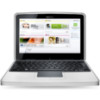Nokia Booklet 3G User Guide - Page 10
Booklet 3G. - support
 |
View all Nokia Booklet 3G manuals
Add to My Manuals
Save this manual to your list of manuals |
Page 10 highlights
10 Connectivity waves, they do not need to be in direct line-of-sight. However, they must be within 10 metres (33 feet) of each other, although the connection may be subject to interference from obstructions such as walls or from other electronic devices. This device is compliant with Bluetooth Specification 2.1 + EDR supporting the following profiles: advanced audio distribution, audio/video remote control, basic imaging, file transfer, dial-up networking, fax, generic access, generic object exchange, hard copy cable replacement, human interface device, object push, personal area networking, service discovery application, serial port, headset, and hands-free. To ensure interoperability between other devices supporting Bluetooth technology, use Nokia approved accessories for this model. Check with the manufacturers of other devices to determine their compatibility with this device. Features using Bluetooth technology increase the demand on battery power and reduce the battery life. When the device is locked, only connections to authorized devices are possible. To protect your privacy, deactivate Bluetooth when not using it. Security tips When you are not using Bluetooth connectivity, deactivate it. Press fn + F10, and select the Bluetooth icon. If you have activated flight mode, Bluetooth connectivity is deactivated. Do not pair with or accept connection requests from an unknown device. This helps protect your device from harmful content. Operating the device in hidden mode is a safer way to avoid malicious software. Fast packet data High-speed packet access (HSPA, also called 3.5G) is a network service in UMTS networks and provides high-speed data download and upload. When HSPA support in the device is activated and the device is connected to a UMTS network that supports HSPA, downloading and uploading data such as e-mail and browser pages through the cellular network may be faster. For availability and subscription to data connection services, contact your service provider. USB data cable Your device supports the USB 2.0 specification. USB is compatible with devices such as a keyboard, mouse, camera, hard disk drive, printer, and scanner. Some USB devices may require additional support software, which is usually included with the device. For more information about device-specific software, see the manufacturer's instructions. Connect devices using the USB data cable Connect a compatible USB data cable to a USB port in the device and in your Nokia Booklet 3G. 10 © 2009 Nokia. All rights reserved.















